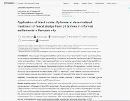| dc.contributor.author | Richard, Tokwaro | |
| dc.contributor.author | Swaib, Semiyaga | |
| dc.contributor.author | Charles, B. Niwagaba | |
| dc.contributor.author | Anne, Nakagiri | |
| dc.contributor.author | Jotham, Ivan Sempewo | |
| dc.contributor.author | Chimdi, Muoghalu | |
| dc.contributor.author | Musa, Manga | |
| dc.date.accessioned | 2023-10-10T11:29:57Z | |
| dc.date.available | 2023-10-10T11:29:57Z | |
| dc.date.issued | 2023-02 | |
| dc.identifier.citation | Tokwaro, R., Semiyaga, S., Niwagaba, C. B., Nakagiri, A., Sempewo, J. I., Muoghalu, C. C., & Manga, M. (2023). Application of black soldier fly larvae in decentralized treatment of faecal sludge from pit latrines in informal settlements in Kampala City. Frontiers in Environmental Science, 11, 138. | en_US |
| dc.identifier.uri | https://doi.org/10.3389/fenvs.2023.1118635 | |
| dc.identifier.uri | https://hdl.handle.net/20.500.12504/1444 | |
| dc.description.abstract | Introduction: Faecal sludge management (FSM) in urban areas of low-and middle-income countries (LMICs) is not properly implemented due to inaccessibility of sanitation facilities and high faecal sludge (FS) emptying costs, amongst others. Unlike in solid waste and fresh human excreta, use of black soldier fly larvae (BSFL) in treatment of FS from pit latrines - which are the most common sanitation facilities in urban areas of LMICs - has not yet been explored. Moreover, the optimal conditions for efficient FS degradation, such as moisture content, feeding rate and larval density are not yet well known. Against this backdrop, the overarching aim of this study was to determine the effectiveness of BSFL in treating FS under different conditions of moisture content, feeding rate and larval density. Also, the quality of residue left after treatment was assessed.
Methods: FS samples were collected from lined and unlined pit latrines in Bwaise I parish in Kampala, Uganda and experiments were set up to feed 10-day old larvae.
Results and Discussion: The optimum feeding rate, larval density and moisture content were found to be 50 mg/larvae/day, 1.33 larvae/cm2 and 60%, respectively. The reduction efficiency at optimum conditions were 72% and 66% for FS from lined and unlined pit latrines, respectively. It was further noted that BSFL can feed on FS from pit latrines without dewatering it, hence there is no need for a dewatering unit. The properties of the residue left after treatment were within the allowable limit for use as compost except for helminth egg concentration. Thus, in informal urban settlements, BSFL can be applied for effective treatment of FS from pit latrines while generating good quality residue thereby providing an additional value chain in FSM. | en_US |
| dc.language.iso | en | en_US |
| dc.publisher | Frontiers in Environmental Science | en_US |
| dc.subject | Faecal sludge management | en_US |
| dc.subject | Black soldier fly larvae | en_US |
| dc.subject | Treatment of faecal sludge | en_US |
| dc.subject | Pit latrines in informal settlements | en_US |
| dc.subject | Kampala City | en_US |
| dc.title | Application of black soldier fly larvae in decentralized treatment of faecal sludge from pit latrines in informal settlements in Kampala city | en_US |
| dc.type | Article | en_US |

